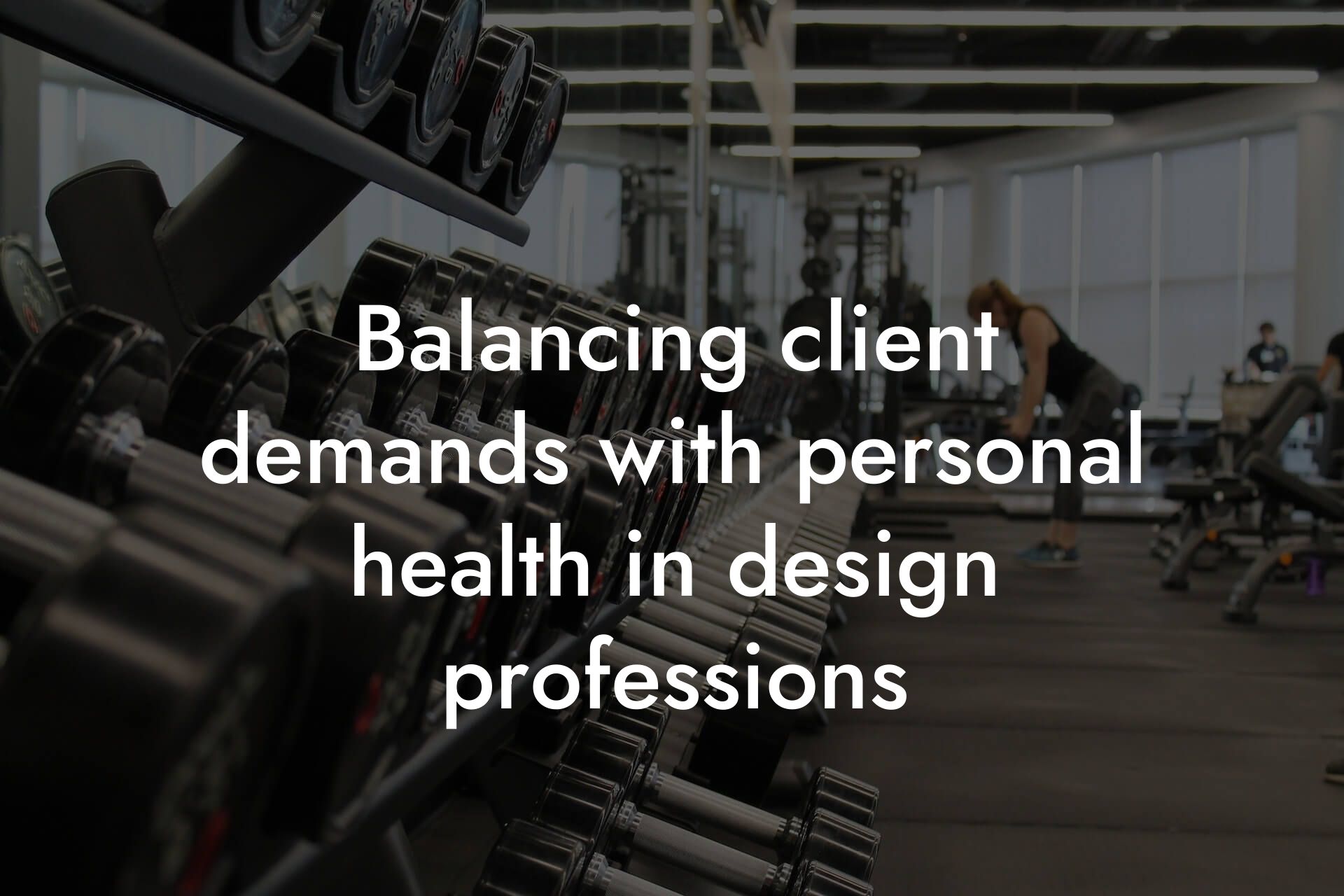As high-earning professionals, you understand the importance of taking care of your physical health to maintain peak performance in your career. At Tano Performance Group, we believe that a healthy body is essential to achieving success in the business world. One often overlooked aspect of physical health is the impact of ergonomic workspace design on your overall well-being. In this article, we'll explore the significance of creating an ergonomic workspace and how it can affect your physical health.
Table of Contents
What is Ergonomic Workspace Design?
Ergonomic workspace design refers to the process of creating a workspace that is tailored to the needs of the user. It involves arranging the workspace to reduce strain and discomfort, and to promote good posture, movement, and overall health. This includes factors such as chair height, monitor placement, keyboard and mouse position, and even the type of lighting used.
The Risks of Poor Ergonomic Design
Poor ergonomic design can lead to a range of physical health problems, including musculoskeletal disorders, eye strain, and even mental health issues. Some common risks associated with poor ergonomic design include:
- Back and neck pain: Poor posture and inadequate chair support can lead to strain on the back and neck, resulting in chronic pain and discomfort.
- Carpal tunnel syndrome: Improperly positioned keyboards and mice can cause strain on the wrists and hands, leading to carpal tunnel syndrome and other repetitive strain injuries.
- Eye strain: Inadequate lighting and poorly positioned monitors can cause eye strain and fatigue.
- Headaches and migraines: Poor ergonomic design can lead to tension and stress, which can trigger headaches and migraines.
The Benefits of Ergonomic Workspace Design
On the other hand, a well-designed ergonomic workspace can have numerous benefits for your physical health, including:
- Reduced pain and discomfort: A workspace designed to promote good posture and reduce strain can help alleviate chronic pain and discomfort.
- Improved productivity: A comfortable and well-designed workspace can help you stay focused and productive, leading to increased efficiency and success.
- Enhanced overall health: By reducing the risk of musculoskeletal disorders and other health problems, ergonomic workspace design can contribute to overall physical health and well-being.
Key Elements of an Ergonomic Workspace
So, what makes an ergonomic workspace? Some key elements to consider include:
- Chair height and lumbar support: A chair that is adjustable and provides adequate lumbar support can help promote good posture and reduce back pain.
- Monitor placement: Monitors should be placed at a comfortable distance and height to reduce eye strain and promote good posture.
- Keyboard and mouse position: Keyboards and mice should be positioned to reduce strain on the wrists and hands.
- Lighting: Adequate lighting can help reduce eye strain and promote a comfortable working environment.
Creating an Ergonomic Workspace on a Budget
You don't have to break the bank to create an ergonomic workspace. Here are some budget-friendly tips to get you started:
- Start with small changes: Begin by making small adjustments to your workspace, such as adjusting your chair height or monitor placement.
- Invest in a good chair: A good chair can make a big difference in promoting good posture and reducing back pain.
- Consider DIY solutions: You can create your own ergonomic solutions, such as using a stack of books to elevate your monitor or creating a makeshift standing desk.
Common Mistakes to Avoid
When creating an ergonomic workspace, there are some common mistakes to avoid, including:
- Ignoring your body: Pay attention to your body and take regular breaks to stretch and move.
- Overlooking the importance of ergonomics: Don't underestimate the impact of ergonomic design on your physical health.
- Failing to adjust: Don't be afraid to make adjustments to your workspace as needed.
In conclusion, ergonomic workspace design is a critical aspect of maintaining physical health and achieving success in the business world. By understanding the risks of poor ergonomic design and the benefits of a well-designed workspace, you can take steps to create a comfortable and healthy working environment. Remember, small changes can add up to make a big difference in your overall health and well-being.
Taking it to the Next Level with DEXA Scans
At Tano Performance Group, we understand the importance of taking a holistic approach to physical health. That's why we offer DEXA scans as part of our comprehensive body assessment services. By combining ergonomic workspace design with a deep understanding of your body composition, bone density, and other health metrics, you can take your physical health to the next level and achieve peak performance in your career.
Frequently Asked Questions
What is ergonomic workspace design?
Ergonomic workspace design refers to the arrangement of a workspace to reduce strain and discomfort on the body. It involves designing the workspace to fit the needs of the worker, taking into account factors such as posture, movement, and comfort. This can include adjusting the height of chairs and desks, positioning of computer monitors, and providing adequate lighting and ventilation.
Why is ergonomic workspace design important for physical health?
Ergonomic workspace design is important for physical health because it can help prevent injuries and reduce the risk of chronic conditions such as back pain, carpal tunnel syndrome, and eye strain. When a workspace is designed with ergonomics in mind, it can help reduce fatigue, improve productivity, and promote overall well-being.
What are the most common ergonomic mistakes in workspace design?
Some of the most common ergonomic mistakes in workspace design include inadequate lighting, poor posture, and incorrect positioning of computer monitors and keyboards. Additionally, failing to provide adequate breaks and ignoring the needs of employees with disabilities can also be significant mistakes.
How can I design an ergonomic workspace on a budget?
Designing an ergonomic workspace on a budget can be achieved by making small changes, such as adjusting the height of chairs and desks, using free online resources to assess workspace ergonomics, and prioritizing the most critical changes. Additionally, considering the long-term benefits of ergonomic design, such as reduced absenteeism and increased productivity, can help justify the investment.
What are the benefits of ergonomic workspace design for employees?
The benefits of ergonomic workspace design for employees include reduced fatigue, improved productivity, and a lower risk of injury and chronic conditions. Additionally, ergonomic design can also improve employee morale and job satisfaction, leading to increased retention and reduced turnover.
How can I measure the effectiveness of ergonomic workspace design?
The effectiveness of ergonomic workspace design can be measured through employee surveys, injury and absenteeism rates, and productivity metrics. Additionally, conducting regular ergonomic assessments and making adjustments as needed can help ensure that the workspace remains optimized for employee health and well-being.
What are the most common ergonomic injuries in the workplace?
The most common ergonomic injuries in the workplace include musculoskeletal disorders, carpal tunnel syndrome, tendonitis, and back pain. These injuries can be caused by repetitive strain, poor posture, and inadequate workspace design.
How can I prevent ergonomic injuries in the workplace?
Ergonomic injuries can be prevented by designing a workspace that takes into account the needs of employees, providing regular breaks, and encouraging employees to report any discomfort or pain. Additionally, providing training on proper lifting techniques, posture, and workspace ergonomics can also help prevent injuries.
What is the role of management in promoting ergonomic workspace design?
Management plays a critical role in promoting ergonomic workspace design by providing resources and support for ergonomic initiatives, setting a positive tone for employee health and well-being, and leading by example. Additionally, management can also help to identify and address ergonomic hazards in the workplace.
How can I get employees to buy into ergonomic workspace design?
Employees can be encouraged to buy into ergonomic workspace design by involving them in the design process, providing education and training on the benefits of ergonomics, and recognizing and rewarding employees who take an active role in promoting ergonomic design.
What are the benefits of ergonomic workspace design for employers?
The benefits of ergonomic workspace design for employers include reduced absenteeism, increased productivity, and lower workers' compensation costs. Additionally, ergonomic design can also improve employee morale and job satisfaction, leading to increased retention and reduced turnover.
How can I balance the needs of different employees in ergonomic workspace design?
The needs of different employees can be balanced in ergonomic workspace design by conducting individual ergonomic assessments, providing adjustable furniture and equipment, and encouraging open communication and feedback. Additionally, considering the needs of employees with disabilities can also help to ensure that the workspace is inclusive and accessible.
What is the relationship between ergonomic workspace design and employee engagement?
There is a strong relationship between ergonomic workspace design and employee engagement. When employees feel comfortable and supported in their workspace, they are more likely to be engaged and motivated. Additionally, ergonomic design can also help to promote a sense of well-being and job satisfaction, leading to increased employee engagement.
How can I ensure that ergonomic workspace design is sustainable over time?
Ergonomic workspace design can be ensured over time by conducting regular ergonomic assessments, providing ongoing training and education, and making adjustments as needed. Additionally, incorporating ergonomic design into company policies and procedures can also help to ensure that it remains a priority over time.
What are the most common myths about ergonomic workspace design?
Some of the most common myths about ergonomic workspace design include the idea that it is only necessary for employees who are injured or have a disability, that it is too expensive, or that it is not relevant to certain industries or job types. However, ergonomic design is important for all employees and can have a significant impact on productivity, morale, and overall well-being.
How can I overcome resistance to ergonomic workspace design?
Resistance to ergonomic workspace design can be overcome by providing education and training on the benefits of ergonomics, involving employees in the design process, and addressing concerns and misconceptions about ergonomic design. Additionally, highlighting the business case for ergonomic design, such as reduced absenteeism and increased productivity, can also help to build support.
What are the benefits of ergonomic workspace design for remote workers?
The benefits of ergonomic workspace design for remote workers include reduced risk of injury and chronic conditions, improved productivity, and increased job satisfaction. Additionally, ergonomic design can also help remote workers to feel more connected to the organization and reduce feelings of isolation.
How can I design an ergonomic workspace for a home office?
Designing an ergonomic workspace for a home office can be achieved by considering the same principles as an office workspace, such as adequate lighting, comfortable seating, and proper positioning of computer monitors and keyboards. Additionally, creating a dedicated workspace and establishing a routine can also help to promote productivity and well-being.
What are the most important ergonomic considerations for computer users?
The most important ergonomic considerations for computer users include proper positioning of the computer monitor, keyboard, and mouse, taking regular breaks, and maintaining good posture. Additionally, considering the height and comfort of the chair, as well as the positioning of the feet, can also help to reduce the risk of injury and discomfort.
How can I prioritize ergonomic design in a fast-paced work environment?
Ergonomic design can be prioritized in a fast-paced work environment by conducting regular ergonomic assessments, providing training and education on the benefits of ergonomics, and making adjustments as needed. Additionally, incorporating ergonomic design into company policies and procedures can also help to ensure that it remains a priority over time.
What is the role of technology in promoting ergonomic workspace design?
Technology can play a significant role in promoting ergonomic workspace design by providing tools and resources to assess and improve workspace ergonomics, such as ergonomic software and apps. Additionally, technology can also help to facilitate remote work and provide ergonomic solutions for remote workers.
How can I measure the return on investment of ergonomic workspace design?
The return on investment of ergonomic workspace design can be measured through reduced absenteeism, increased productivity, and lower workers' compensation costs. Additionally, conducting regular surveys and assessments can also help to measure the impact of ergonomic design on employee health and well-being.
Here are some related articles you might love...
- The importance of physical fitness in architectural presentations
- Balancing client demands with personal health in design professions
- How to avoid burnout through physical activity in architecture
- How DEXA scans can benefit architects and designers
- Fitness strategies for balancing design work and physical health
- Nutrition for maintaining creativity and energy in design work
- The connection between body composition and creative output
- How architects can stay fit during long design sessions
- How to stay active during the design and build phases
Zak Faulkner
Zak Faulkner is a leading authority in the realm of physical health and body composition analysis, with over 15 years of experience helping professionals optimise their fitness and well-being. As one the experts behind Tano Performance Group, Zak has dedicated his career to providing in-depth, science-backed insights that empower clients to elevate their physical performance and overall health.
With extensive knowledge of DEXA technology, Zak specializes in delivering comprehensive body assessments that offer precise data on body fat, muscle mass, bone density, and overall physique. His expertise enables individuals to make informed decisions and achieve their fitness goals with accuracy and confidence. Zak’s approach is rooted in a deep understanding of human physiology, combined with a passion for helping clients unlock their full potential through personalised strategies.
Over the years, Zak has earned a reputation for his commitment to excellence, precision, and client-focused service. His guidance is trusted by top professionals who demand the best when it comes to their health. Whether advising on fitness programs, nutritional strategies, or long-term wellness plans, Zak Faulkner’s insights are a valuable resource for anyone serious about taking their health and fitness to the next level.
At Tano Performance Group, Zak continues to lead our Content Team revolutionising how professionals approach their physical health, offering unparalleled expertise that drives real results.




